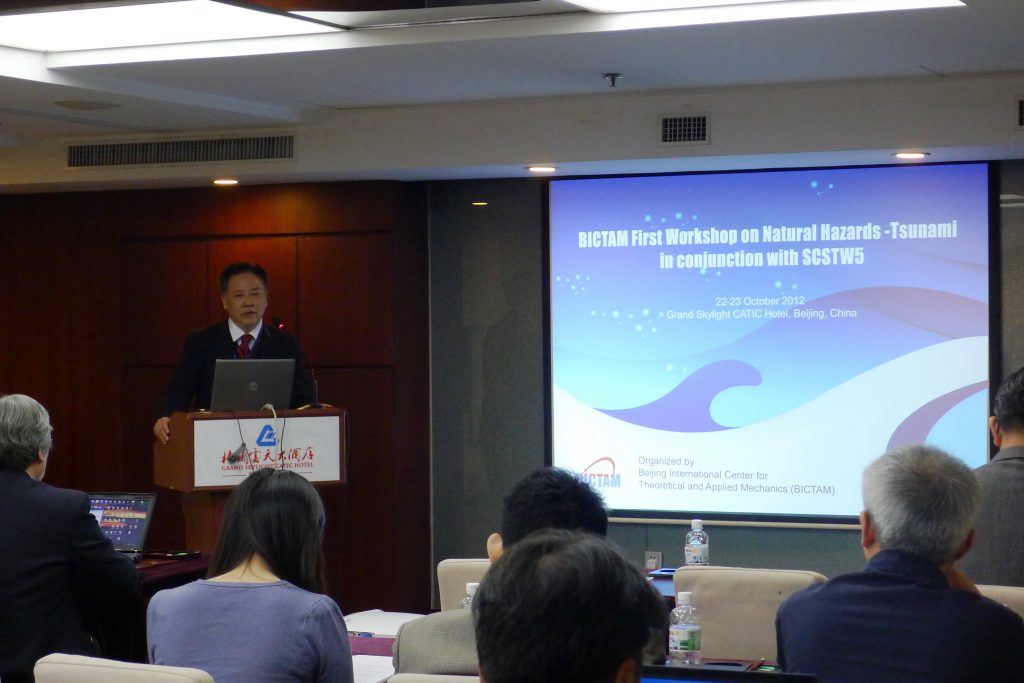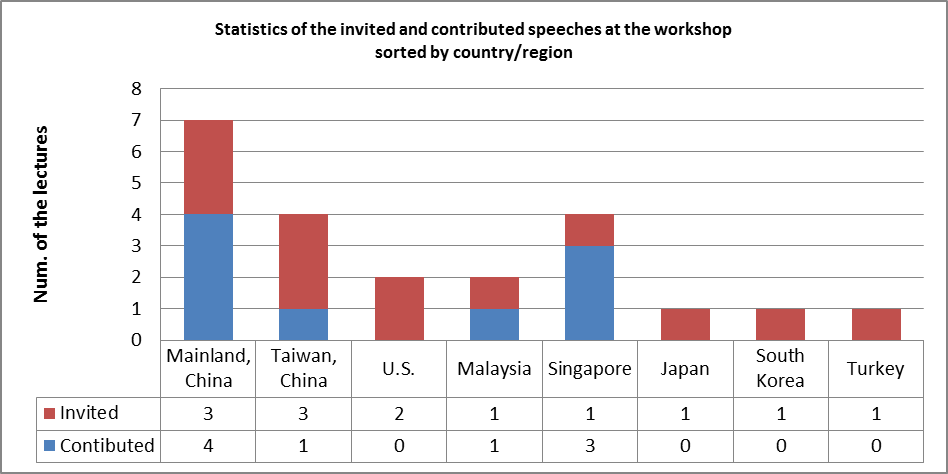BICTAM First Workshop on Hazard – Tsunami in conjunction with SCSTW5 was held in Beijing from Oct. 22 to Oct. 23 in 2012. More than 30 participants from China, U.S., Malaysia, Singapore, Japan, South Korea and Turkey attended this meeting. The workshop was organized by the Beijing International Center for Theoretical and Applied Mechanics (BICTAM), and co-sponsored by China Association for Technical and Science (CAST), National Natural Science Foundation of China, The Chinese Society of Theoretical and Applied Mechanics (CSTAM), Institute of Mechanics, CAS (IMCAS), Shanghai Jiao Tong University of China, and Cornell University of USA.
At the Opening Session, Prof. Jiachun Li of IMCAS, Co-chair of the workshop, expressed his welcome to all of the participants and gave a brief introduction on the background. He stressed “the objectives of this workshop is, to deepen mechanism understanding, achieve accurate forecast and give early warning on Tsunami hazard by combing effective counter-measure and actions”. He also emphasized that one aspect of BICTAM’s activities had been focused on the natural disaster reduction and so it’s a good opportunity for BICTAM to organize the workshop on Tsunami in conjunction with the serial South China Sea Workshop on Tsunami starting from 2007.

The workshop is consisting of invited and contributed presentations. Prof. Philip L-F Liu, also the co-chair the workshop, gave a keynote speech entitled “Surface Waves Through Emergent Coastal Trees”, in which his study on the effects of emergent coastal forests on the propagation and dissipation of surface long waves and intermediate depth waves were introduced and a theoretical model describing the dynamics of surface long waves and intermediate waves through coastal forests was developed in theoretical and experimental analysis.

During two days, 19 presentations, including 11 invited lectures, had been arranged in the four sessions by topics: Tsunami Genesis and Propagation, Effects and Impacts of Tsunami Hazards, Tsunami Forecast and Warning System, and Tsunami Hazard Mitigation and Resilience. The latest results of the research on Tsunami from different teams were presented in the workshop. See the statistics as below.

Especially, a panel discussion chaired by Prof. Philip L-F Liu was organized after the lectures, researchers had a deep discussion focusing on the key problems involved in tsunami hazards. The following are some of views and opinions on the Tsunami study at present and in the future.
1. Dynamical model of tsunami source
During tsunami process, the transport and interaction with coast strongly depend on the tsunami source model. Since tsunami usually is excited by underwater landslides, subsidence and fracture fault, researchers suggested that, the source model should be established considering complex geometry based on seabed topography. As for fracture fault, vertical motion speed and relative dislocation magnitude and areas should be accounted for. The natural characteristics of tsunami source is evidently related to the issues in earth dynamics such as sustaining displacement of tectonic plates both globaly and in the source region.
2. Quantitative study on the influences of topography-related coefficients of nonlinearity, dispersion, dissipation in the mathematic model on propagation, runup and eventual inundation.
The mathematical model of tsunami should include the effects of dispersion on propagation in open sea and nonlinearity on runup in shoaling region. As approaching the coast, topography plays more important role in the evolution of tsunami due to shallower water. Only if with these three significant factors considered, the model can predict accurate arrival time and wave height, reflect full physical characteristics and also reveal actual mechanism during every process of tsunami evolution.
3. Tsunami warning system and data share
The frequently happening tsunamis all over the world have attracted the attention of reserachers at present. So it became hot discussion topics as to how to predict and prevent tsunami hazards and how to develop a warning system. Researchers have suggested that a robust disaster monitor, data acquisition, information communication network system should be established in order to fulfill the mission of Tsunami hazard mitigation. A batch of techniques and systems of monitering deepsea earthquake are implemented or under research now, including:
- Satellite remote sense. Advanced techniques of satellite radar and laser altimeter are in a mature state, which have already observed the transport of tsunami wave in ocean. The data obtained could be used to correct the tsunami model, and provide important evidence to improve the tsunami warning system.
- Measuring seismic fracture parameters accurately
- Observation in deep sea
4. Mitigation techniques on tsunami
From the view point of environment science, developing a natural ecosystem along coast, for example, planting mangrove ( a “buffer” to defend the impact of sea wave) will be benefcial to the reduction of tsunami hazard. Besides, ocean structures like breakwater, underwater dune are also very effective to lessen instant impact and moving speed of tsunami. So, a series of on-going scientific projects such as dynamical model of interaction between tsunami and protective structures should be further promoted.
Finally, participants suggested that the symposium or workshop on tsunami should be convened regularly so that timely exchange of the latest advances in this field is made possible.
At the Closing Session, Prof. Jiachun Li gave an endnote speech entitled “Challenging Issues of Natural Disasters Reduction and BICTAM Future Activities” to summarize the scientific plans raised by the UN, ICSU, and other international organizations in recent two decades and stated that the disaster reduction had become one of the interdisciplinary frontiers. In regard to the BICTAM’s future program, Prof. Li mentioned that the natural disaster reduction, such as meteorological disasters (tropical cyclone, heavy rain, dust storm, heat wave, frozen), marine disasters (rouge wave, internal tide, storm surge, tsunami, red tide), hydraulic disasters (soil erosion, flood, salt invasion) and geological disasters (volcano eruption, earthquake, landslide, debris flow, etc.), is always one of the focus of BICTAM activities.
At last, Prof. Li expressed his wish that scientific activities in the form of symposia or summer school etc., would certainly facilitate people there to enhance their capability against various natural calamities in these countries, especially in the Asia, as a developing country dominated continent and vulnerable to natural disasters.

We acknowledged the financially support of The Chinese Society of Theoretical and Applied Mechanics (CSTAM), Institute of Mechanics, CAS (IMCAS), and Shanghai Jiao Tong University of China.
November, 2012
BICTAM Office